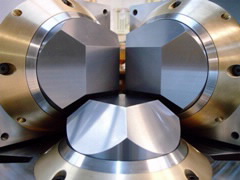 |
| Beamline science to take us on a virtual journey to the centre of the Earth. |
A new agreement between Macquarie University and the Australian Nuclear Science and Technology Organisation (ANSTO) will help us better understand everything from where earthquakes might occur to where gold is deposited.
The partnership provides joint funding for a senior-level research appointment in the University’s Department of Earth and Planetary Sciences. This arrangement is the first of its kind between the University and ANSTO.
The successful appointee will help lead work to replicate environments 400 kilometres beneath earth’s surface: specifically a layer called the upper mantle, which is the source of most magma or molten rock beneath the surface.
The study of the physical and chemical processes at these depths will provide a better understanding of the earth, including how mineral deposits are formed.
And by providing a fuller working model of the processes that occur in the earth’s interior, scientists hope to better understand how to predict and anticipate geologic events such as earthquakes and volcanic eruptions.
Along with the appointment is building of the first multi-anvil experimental facility on the Australian Synchrotron: delivering the first high pressure synchrotron facility for geoscience research. Each anvil is effectively a hydraulic ram.
(This new equipment and research facility will be funded by Macquarie University and an Australian Research Council Linkage Infrastructure, Equipment and Facilities grant.)
The new researcher will use both the Melbourne-based synchrotron and the Sydney-based OPAL research reactor. To this point, high-pressure research has been conducted primarily in the US and Japan, so this is an Australian first.
“We are pleased to announce this joint venture which will take advantage of unique Australian infrastructure and forms part of the increasing momentum within the earth science community to use such facilities,” said Professor Jim Piper, the University’s Deputy Vice-Chancellor (Research).
“The multi-anvil research facility will enable real time, high pressure, high temperature experiments on deep earth materials. The experiments will inform models for the chemical and physical evolution of the earth and other planets,” he said.
Dr Rob Robinson is the Head of ANSTO’s Bragg Institute, which leads Australia in the use of neutron scattering and x-ray techniques to solve complex research and industrial problems.
“This project is a great example of how ANSTO can collaborate with both the university sector and the Australian Synchrotron to deliver research that benefits science and the community in general,” Dr Robinson said.
“There could be numerous exciting applications for this science, both now and as it is further developed.
“In the future, ANSTO will also look to develop a sister high-pressure facility on our campus, which would run on the OPAL Reactor’s neutron beam lines and investigate the behaviour of light elements in these systems.”
Head of Science at the Australian Synchrotron, Professor Andrew Peel, also welcomed the announcement saying it places Australian scientists at the forefront of geoscience research.
Published: 22/11/2011

